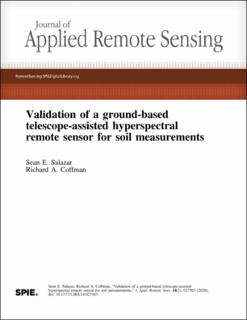Validation of a ground-based telescope-assisted hyperspectral remote sensor for soil measurements
Peer reviewed, Journal article
Published version
Permanent lenke
https://hdl.handle.net/11250/2656447Utgivelsesdato
2020Metadata
Vis full innførselSamlinger
- NGI articles [1026]
Sammendrag
The utility of the ground-based soil observation laser absorption spectrometer (SOLAS) was demonstrated through spectral reflectance measurements of five soil types during laboratory- and field-based collection. The SOLAS telescope-assisted measurements were compared with proximal measurements. The spectra that were acquired at an intermediate range of 40 meters compared well with the spectra that were acquired proximally. Specimen type, range-dependent spatial resolution, and environmental conditions are discussed. The signal-to-noise ratio (SNR) was assessed and is presented as a function of wavelength for the spectral range of the receiver for each measurement condition. The proximal measurements performed outdoors under solar illumination had the greatest SNR, while the remote measurements performed indoors under artificial illumination had the lowest SNR. For the outdoor measurements, loss of signal was observed around the 1400- and 1900-nm bands due to long-path atmospheric water vapor absorption. The discussed future improvements to the SOLAS remote sensor will enable measurements of reflectance over longer ranges. Envisioned applications include remote characterization of surface materials for large construction projects (e.g., surface mines and tailings) for geohazard investigations, or for ground truthing of current and future multispectral and hyperspectral satellite data.
